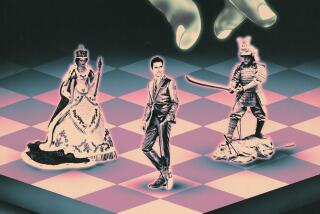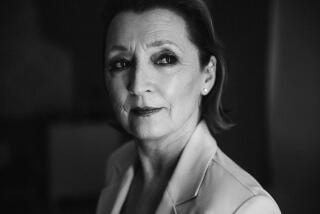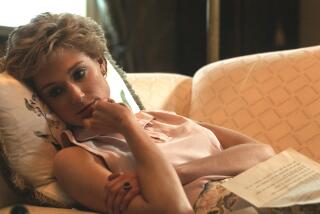Review: âThe Crownâsâ Season 2 shines with a stellar turn by Claire Foy as the queen facing a lonely path
The story of Queen Elizabeth II in Netflixâs âThe Crownâ provides plenty of â50s and â60s nostalgia when it returns Friday. But itâs the eloquent depictions of governing protocol, diplomatic decorum and a leader who puts country above self-interest that lends the series a new relevance.
Season 2 of the award-winning royal drama arrives with high expectations as it follows the story of Britainâs longest-reigning monarch, Elizabeth (Claire Foy), from 1956 to 1963.
The 10-episode season does not disappoint as it advances the narrative of a young queen â grappling with limited political power, immense cultural influence and a fraying marriage â into the second half of the 20th century.
Like Britain itself at the time, Season 2 faces a monumental task: how to move onward and upward without the guiding presence of Winston Churchill.
In the debut season the prime minister anchored the post-war era and mentored Elizabeth, who took the throne at age 25 upon her fatherâs death. John Lithgow gave one of the best performances of his career as the phenomenal and flawed Churchill, winning an Emmy award for his efforts, opposite another phenomenal performance by Foy.
Now Elizabeth is 30 and essentially on her own. Her husband, Prince Philip, the Duke of Edinburgh (Matt Smith), is floundering with what he sees as his nonessential role as sidekick to the queen. Englandâs new PM, Anthony Eden (Jeremy Northam), is practically paralyzed by the legacy of his predecessor. All the monarch has are her royal Corgi pups, her private secretary Michael Adeane (Will Keen) and her unbreakable poise.
Foy has no problem filling the void left by Lithgowâs Churchill with another stellar performance that builds upon the experience and confidence Elizabeth gained last season. The queen is still oppressed by royal duty and her life in the public eye, but has reconciled her conditioning to put the crown above all else with her own sense of self. Essentially, she buries whoever that self is deep, and embraces her part, becoming a calming and steady figurehead in unsteady times.
The actress conveys the queenâs displeasure or worry in the slightest of gestures â a flickering of a blink in one eye, the subtle pursing of her lips, a slight pause in her stiff gait. Though nearly undetectable, the glitches in her controlled mannerisms are as telling as a dramatic outburst.
In the seriesâ open she spends every moment mastering an appearance of normalcy and order while rumors swirl about her husbandâs infidelity, and Britain instigates a Mideast conflict, which plunges the country into an economic crisis.
Elizabethâs personal life, Philipâs identity crisis and the geopolitics of the era are seamlessly triangulated here. âThe Crown,â written predominantly by showrunner and playwright Peter Morgan, intertwines key historical events with the personal dramas inside Buckingham Palace. Story lines as far flung as the rise of Egyptâs Abdel Nasser, and the indigenous tribes of Tonga that Philip encounters on a world tour, of course tell us something about the changing world, but they also illuminate the sympathies and blind spots of the royals.
They are at once sheltered and knowing: Elizabeth is intrigued by the exotic notion of grocery shopping, Philip co-founded a menâs-only lunch club where anything goes. Both are trapped in a marriage that, no matter what, must remain intact for the survival of the monarchy since scandal and palace intrigue are national pastimes.
Lovely old British-isms are plentiful throughout âThe Crown.â Palace advisors âdonât give a figâ about anyoneâs reputations but the royals theyâre in service of and the strongest term a high-ranking political figure uses to describe Britainâs standing after the militaryâs retreat in Sinai is that their âreputation is in tatters.â
Elizabeth does not have as much screen time as she did when the series debuted last year, but her presence is implicit throughout the restless Philipâs journeys, as well as the subplots involving her rebellious sister, Margaret (Vanessa Kirby). In contrast, Elizabeth is the picture of conservative poise in her olive cardigan, conservative day dress and sensible handbag she carries about over one arm. Yet she owns her power in an era when women held few positions of authority. On the occasions she dons the ceremonial robe and crown, itâs clear she was born to wear the clothing of a leader, while Philip looks like a boy playing dress up.
Most refreshing, and perhaps timely, is that the young Elizabeth in Season 2âs first few episodes firmly believes in the sanctity and importance of her position. She is serving her country, and the crown, and sacrifices most of her personal life â fairly or unfairly â to fulfill her duty. The depiction may have felt a bit too earnest, and maybe even corny a couple years ago, but today it speaks to a void in leadership from all corners of Washington, and a prevailing cynicism that decorum is dead.
âThe Crownâ
Where: Netflix
When: Any time, starting Friday
Rating: TV-MA (may be unsuitable for children under the age of 17)
More to Read
The complete guide to home viewing
Get Screen Gab for everything about the TV shows and streaming movies everyoneâs talking about.
You may occasionally receive promotional content from the Los Angeles Times.







